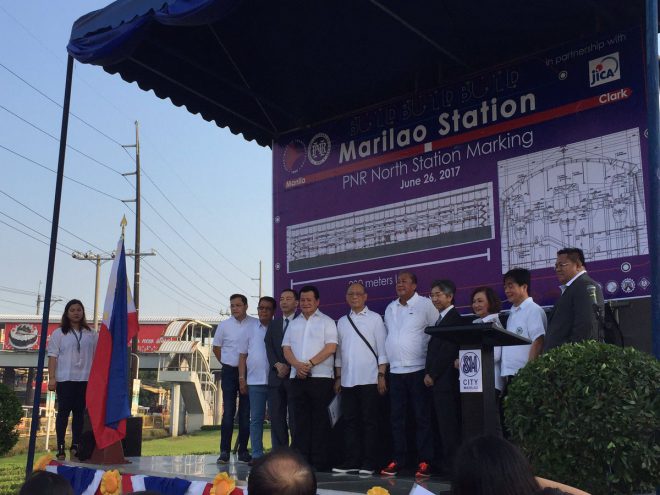Philippines marks stations for the JICA-backed North-South Commuter Railway
June 26, 2017
To speed up construction of the North-South Commuter Railway (NSCR) Project, the new railway network that incorporates the latest seismic design, the Department of Transportation (DOTR) and other related key government agencies unveiled this week the markers for the project’s station locations. The Detailed Engineering Design for the NSCR Project, conducted through JICA (Japan International Cooperation Agency) grant, has been nearing completion. The design identified the locations of, and finalized the designs of, all the future stations. “The NSCR aims to boost connectivity of emerging growth centers to Metro Manila and improve the mobility of the Filipino commuters,” said JICA Chief Representative Susumu Ito. “Once completed, it can help address traffic congestion and improve the quality of life of people living and working in urban areas in Metro Manila.” Markers are rising at Marilao and Meycauayan in Bulacan and Valenzuela, Caloocan, and Tutuban in Metro Manila. JICA added that the NSCR will use Japanese technology to ensure commuter safety through Japan's seismic design as well as low emission electric trains for sustainability. The NSCR’s Detailed Engineering Design includes preparing the railway’s detailed design including alignment of the NSCR line, design of elevated structures, architectural designs of stations and depot, technical requirements for signaling system, and rolling stock. The NSCR, together with the Philippines' Metro Manila Subway Project, is part of the mass transit backbone forming the North-South Corridor advocated in the Roadmap for Transport Infrastructure Development Study for Metro Manila and its Surrounding Areas of the National Economic Development Authority (NEDA) and JICA in 2014. The roadmap is being updated. The Philippine government and JICA signed on the 241.99 billion yen ( about $1.992.17 billion) Loan Agreement for the NSCR Project on November 27, 2015. The project, which aims to be operational by 2022, will significantly reduce travel from two hours using traditional transportation to 35 minutes from Malolos to Tutuban. The NSCR will also provide punctual service for commuters. JICA added that once implemented, the NSCR could be a game changer in the Philippines’ public transport system whose population density is 19,000 persons for every one square kilometer, higher than Tokyo and most Asian cities. Since the 1960s, JICA has been supporting Philippine transport infrastructure system through hundreds of roads and bridges to encourage investments and sustain economic growth. DMS
Latest Videos
- THE UNTOLD STORY EXPERT INSIGHTS INTO THE UKRAINE
- NEGOTIATING A NEW ORDER US RUSSIA TALKS ON UKRAIN
- Ukraine: A Pawn in the Geopolitical Game? Will Trump Intervene?
- US VP VANCE CRITICIZES EUROPEAN DEMOCRACIES AT MUNICH SECURITY CONFERENCE
- UNCOVERING THE WEB OF DECEIT: CIA INFILTRATION OF THE MEDIA
- SHIFTING SANDS: TULSI GABBARD’S CONFIRMATION AND THE EVOLVING GLOBAL LANDSCAPE
- FAUCI SCANDAL: A THREAT TO GLOBAL HEALTH AND DEMOCRACY






